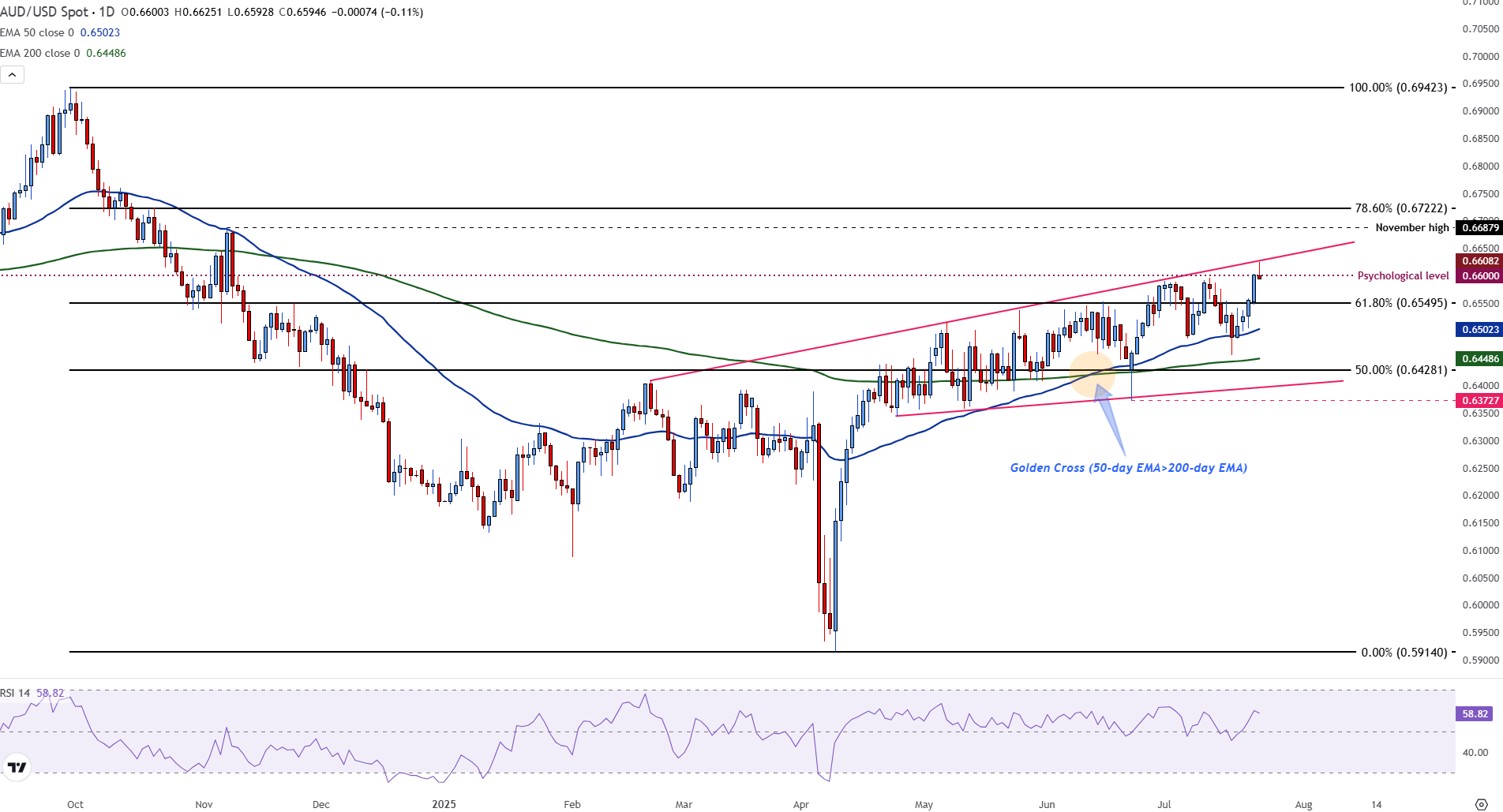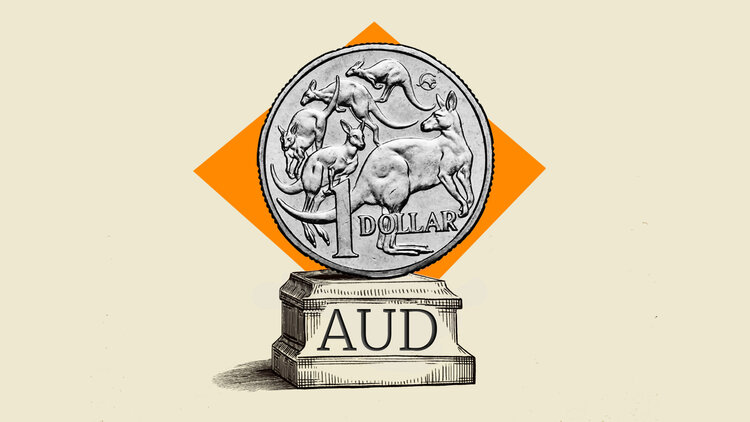- AUD/USD bulls take a breather as triangle resistance caps gains at YTD high.
- Resilient PMI data and hawkish RBA comments drive AUD/USD to eight-month highs as risk sentiment firms.
- The US Dollar remains under pressure despite lower-than-expected Initial Jobless Claims and steady yields.
The Australian Dollar (AUD) is pulling back after hitting an eight-month high against the US Dollar (USD) on Thursday. The pair reached a session high of 0.6625 before easing to trade near 0.6596 at the time of writing.
The retreat follows a strong rally driven by upbeat economic data and improving global risk sentiment. As the pair approached key resistance, profit-taking and fading momentum triggered the pullback.
The rally was fueled by signs of economic resilience in Australia. The preliminary Composite Purchasing Managers Index (PMI), released on Wednesday, rose to 53.6 in July, the highest in over two years. The index tracks activity in services and manufacturing, showing broad-based expansion. Strong domestic demand and a rebound in industrial output supported the result. The data reduced expectations for near-term rate cuts by the Reserve Bank of Australia (RBA).
AUD/USD rises on strong domestic data, steady RBA outlook, and shifting US Dollar dynamics
Reinforcing this outlook, RBA Governor Michele Bullock stated that while rates remain on hold at 3.85%, Australia’s interest rate cycle may prove shallower than in other advanced economies. Her balanced message underscored the central bank’s commitment to reducing inflation without undermining employment, thereby strengthening investor confidence in the AUD’s fundamental backdrop.
Her balanced message emphasized the need for inflation control without significantly harming the labor market, thereby bolstering confidence in the currency’s long-term fundamentals.
US data released Thursday also reflected economic resiliency. Initial Jobless Claims came in at 217,000, below forecasts, suggesting that the labour market remains robust. The S&P Global US Composite PMI rose to 54.6, the fastest pace in over a year, despite a disappointing Manufacturing PMI reading. While US economic data remains robust, the US Dollar has shown signs of fatigue amid growing political scrutiny of the Federal Reserve (Fed) and growing expectations that rates will be lowered this year.
This environment has narrowed the interest rate differential with the AUD, making it more attractive to investors seeking returns.
Externally, global risk sentiment has improved, particularly as concerns around major trade disputes have eased.
AUD/USD bulls take a breather as triangle resistance caps gains at YTD high
AUD/USD is retreating after failing to hold above the key resistance zone near 0.6600–0.6625. This area includes the upper boundary of a rising wedge pattern and marks the highest level since November 2024. The pullback suggests hesitation from buyers as momentum slows.
The Relative Strength Index (RSI) has eased slightly, now hovering around 59, showing that while bullish momentum remains, it’s losing steam. A break below immediate support at 0.6550, a prior breakout level and near the 61.8% Fibonacci retracement of the September-April decline, could open the way to 0.6500, where the 50-day Exponential Moving Average (SMA) and lower channel support converge.
On the upside, a decisive close above 0.6625 would confirm a breakout from the rising wedge and could trigger a move toward the next resistance at 0.6722, the November 2024 high. Until then, consolidation or a deeper pullback remains possible if risk appetite softens.
Technically, AUD/USD is trading within a rising channel and recently bounced off the 61.8% Fibonacci retracement level at 0.6550, maintaining a bullish structure. The Relative Strength Index (RSI) is approaching 59, indicating strong buying interest without overbought conditions. Additionally, the presence of a Golden Cross — where the 50-day EMA crosses above the 200-day EMA — continues to support a bullish medium-term outlook.

Key levels to monitor include resistance at 0.6600, which coincides with a psychological and structural barrier, and a higher target at 0.6722, the November 2024 high. On the downside, immediate support lies at 0.6550, with further backing from the 50-day EMA and the lower boundary of the rising channel near 0.6498. A decisive break above 0.6600 would open the door for a move toward 0.6722, while failure to hold above support could trigger a deeper pullback.
Australian Dollar FAQs
One of the most significant factors for the Australian Dollar (AUD) is the level of interest rates set by the Reserve Bank of Australia (RBA). Because Australia is a resource-rich country another key driver is the price of its biggest export, Iron Ore. The health of the Chinese economy, its largest trading partner, is a factor, as well as inflation in Australia, its growth rate and Trade Balance. Market sentiment – whether investors are taking on more risky assets (risk-on) or seeking safe-havens (risk-off) – is also a factor, with risk-on positive for AUD.
The Reserve Bank of Australia (RBA) influences the Australian Dollar (AUD) by setting the level of interest rates that Australian banks can lend to each other. This influences the level of interest rates in the economy as a whole. The main goal of the RBA is to maintain a stable inflation rate of 2-3% by adjusting interest rates up or down. Relatively high interest rates compared to other major central banks support the AUD, and the opposite for relatively low. The RBA can also use quantitative easing and tightening to influence credit conditions, with the former AUD-negative and the latter AUD-positive.
China is Australia’s largest trading partner so the health of the Chinese economy is a major influence on the value of the Australian Dollar (AUD). When the Chinese economy is doing well it purchases more raw materials, goods and services from Australia, lifting demand for the AUD, and pushing up its value. The opposite is the case when the Chinese economy is not growing as fast as expected. Positive or negative surprises in Chinese growth data, therefore, often have a direct impact on the Australian Dollar and its pairs.
Iron Ore is Australia’s largest export, accounting for $118 billion a year according to data from 2021, with China as its primary destination. The price of Iron Ore, therefore, can be a driver of the Australian Dollar. Generally, if the price of Iron Ore rises, AUD also goes up, as aggregate demand for the currency increases. The opposite is the case if the price of Iron Ore falls. Higher Iron Ore prices also tend to result in a greater likelihood of a positive Trade Balance for Australia, which is also positive of the AUD.
The Trade Balance, which is the difference between what a country earns from its exports versus what it pays for its imports, is another factor that can influence the value of the Australian Dollar. If Australia produces highly sought after exports, then its currency will gain in value purely from the surplus demand created from foreign buyers seeking to purchase its exports versus what it spends to purchase imports. Therefore, a positive net Trade Balance strengthens the AUD, with the opposite effect if the Trade Balance is negative.

